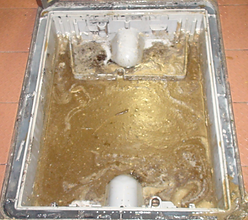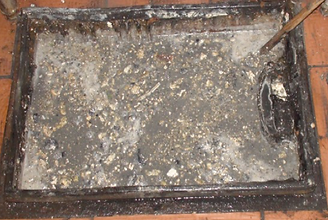
Grease Traps - Total Solution?

Grease traps are the first line of defense to prevent grease and oil from reaching drain pipes and wreaking havoc on them and other downstream facilities.
Most cities require the installation of grease traps as a preliminary step to setting up a Restaurant or Hotel.
In some places, compliance with a cleaning plan is required with the removal and transfer of the grease, by an authorized company, to a final disposal site.
How do they work?
%201.png)
The grease traps work by gravity, in the flow of water that is discharged from the sinks there are heavier elements that settle to the bottom (heavy wet solids) and the greases (together with the light wet solids) that float to the surface . Wet solids are usually food debris that passes through the drains. The outlet of the trap must have an elbow (with an air inlet outside the trap) or an internal "T", to prevent the grease from the surface from escaping into the drain.
%201.png)

The water level inside the trap is defined by the bottom of the outlet tube, the space available between the water level and the roof of the trap, multiplied by the area, is approximately the capacity of the trap . The space between the base and the ceiling, multiplied by the area, gives the total volume of the trap.
Retention time : it is the time necessary for gravity to act and produce an effective separation of the fat, this value can be from 3 to 5 minutes. Taking this reference value and the maximum discharge flow, the volume that the trap must have can be defined.
Outlet pipe: it must be separated from the bottom a sufficient distance so that the outgoing water flow does not suck the solids parked at the bottom.
Cleaning: the grease from the traps must be removed frequently to prevent it from reaching the ceiling or from its own weight coming out through the drain tube. Depending on the activity and the type of food, an active kitchen may need its trap to be cleaned up to 3-4 times a week.
Unfortunately, no matter how often the traps are cleaned, the grease always finds its way to the drain.
The following sequence of photos shows the trap of a facility with a rigorous cleaning system, the kitchen works 24 hours a day, with rotating shifts of staff every 8 hours, each shift change, the traps are cleaned, that is, 3 times a day .




The first photo shows one of the perfectly maintained grease traps, the second is a photo of an external collection pit where there is about a foot of accumulated grease (they are emptied every 10-15 days), finally the third shows the surface from the aerobic phase of the Treatment Plant, where fat is perceived on the surface.
On Grease Traps, Wet Solids, Detergents and Bacteria
Although Grease traps are a necessary device, and in some cases of mandatory installation, in high-activity kitchens, it is not true that they contain up to 97% of the fat that enters them. Due to various factors: water temperature, use of detergents, inadequate cleaning, the retention time of the trap is not respected, etc, etc, etc,. Fats always escape from the traps. Let's see some of them:
Water temperature
The temperature of the water affects the consistency and fluidity of fats, making them more soluble in water as the temperature increases. Of course, when the temperature drops, the fat solidifies again and adheres to the walls of the discharge pipes. In fact, in some cities, municipalities recommend placing coolers in the traps, precisely to stop the fat inside private facilities. and prevent it from reaching public drains.
Use of detergents
Detergents are surfactants, that is, they lower the surface tension between phases which allows grease and water to somehow mix in an emulsion, they are excellent for cleaning surfaces (dishes are perfectly clean) but the molecules they generate are very large and unstable, which causes them to break downstream and release fats again. This is very easy to demonstrate in practice: ALL KITCHENS IN THE WORLD USE DETERGENTS TO CLEAN THEIR DISHES AND ALL HAVE GREASE PROBLEMS.
It does not matter if it is an industrial detergent, biodegradable, green, with chlorine or whatever: THERE IS NO SUCH THING AS "EATING GREASE DETERGENT"
Lack of Cleaning or Inadequate Maintenance
It is very important that the maintenance personnel, or the trap cleaning service provider being familiar with the operation of the traps,


In the trap of the photo on the left, you do not see grease floating at the inlet, but you can see more grease at the outlet elbow, the fact that it is clean indicates that when there is flow the level of the The trap is not maintained (it should be the level of the bottom of the outlet tube) and rises above the separation barrier, on the lid you can see adhering grease. This behavior indicates that the outlet tube is partially blocked.
In the photo on the right, we see the same trap once the outlet tube has being cleaned, note the water level in the trap coinciding with the outlet tube.
Grease trap retention time
For the trap to work effectively, it is necessary that the fluids remain in it until they are separated by flotation. This time is related to the volume of the sinks and the discharge flow, that is, while the sinks are full, how long does it take to empty them.
Traps are usually specified by their grease load capacity (in liters or gallons) and by their flow rate (in liters/min or gal/min). If the flow from the sinks, is greater than that indicated by the trap, it will inevitably overflow.
To select the correct trap, the discharge flow must be estimated, this can be done by measuring the sinks and calculating their volume, the sinks are filled to approximately 75% of the edge, the sink tap is removed, and the time to empy the sinks is measured. The volume divided by time gives us an idea of the maximum flow. A trap with a higher flow rate should be selected.
In general, commercial grease traps have a maximum flow rate of 100 to 120 liters/minute. In other words, if you have 3 sinks of 100 liters each connected to the trap, the trap will not be able to handle all that flow. To solve this, the traps are connected through flow regulators, see photo on the right.
The more the flow rate is increased, the more the retention time decreases and the less effective the trap will be.

Bacteria
Bacteria are highly beneficial in water treatment systems, the reduction of the organic load in water and its purification depends on them. Now inside the grease traps there are some conditions that render bacteria useless:
-
Disinfectants such as chlorine, biocides are used in the wash basins to disinfect fruits and vegetables, etc. that uaually kill bacteria.
-
In many restaurant traps, water is also discharged from dishwasher machines that operate at very high temperatures.
-
The dynamics of the water flow in the trap, is too fast for the bacteria to remain and form colonies, they usually disappear downstream of the trap.

The photo belongs to one of our current clients, the arrow indicates the position of a bag that "in theory" releases bacteria that eliminate fats inside the trap
Demonstrations of our technology in grease traps








The photos show the manual application of the product, as a demonstration, in grease traps of several Hotels and Restaurants in Mérida. For cleaning, only a manual spray was used and no material was extracted from the trap, the existing grease in the trap was simply destroyed. In some cases, the floating material visible on surfaces is floating wet solids (food scraps)
These demos never take more than 10 minutes.





